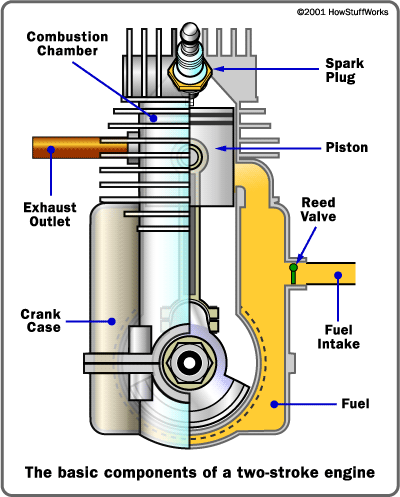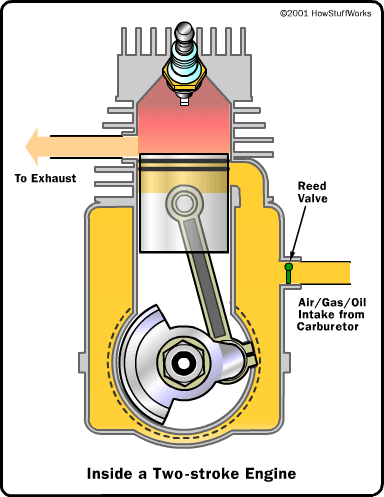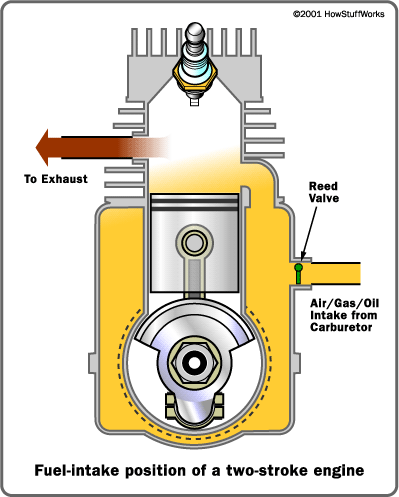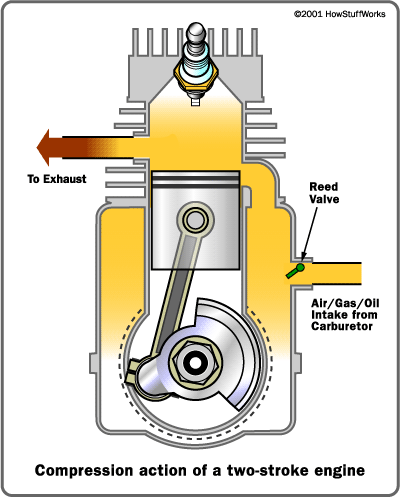| |
| Engineering
>> How Things Work >> How 2-Stroke Engines Work |
| |
| Introduction |
|
|
If you
have read How Car Engines Work and How Diesel Engines Work,
then you are familiar with the two types of engines found
in nearly every car and truck on the road today. Both gasoline
and diesel automotive engines are classified as four-stroke
reciprocating internal-combustion engines.
There
is a third type of engine, known as a two-stroke engine, that
is commonly found in lower-power applications. Some of the
devices that might have a two-stroke engine include:
- Lawn
and garden equipment (chain saws, leaf blowers, trimmers)
- Dirt
bikes
- Mopeds
- Jet
skis
- Small
outboard motors
- Radio-controlled
model planes
In this
article, you'll learn all about the two-stroke engine: how
it works, why it might be used and what makes it different
from regular car and diesel engines. |
|
| Two-stroke
Basics |
|
|
This is
what a two-stroke engine looks like:

You
find two-stroke engines in such devices as chain saws and
jet skis because two-stroke engines have three important advantages
over four-stroke engines:
- Two-stroke
engines do not have valves, which simplifies their construction
and lowers their weight.
- Two-stroke
engines fire once every revolution, while four-stroke engines
fire once every other revolution. This gives two-stroke
engines a significant power boost.
- Two-stroke
engines can work in any orientation, which can be important
in something like a chainsaw. A standard four-stroke engine
may have problems with oil flow unless it is upright, and
solving this problem can add complexity to the engine.
Horsepower
: For a complete explanation of what horsepower is and
what it means to performance, check out How
Horsepower Works.
These advantages make two-stroke engines lighter, simpler
and less expensive to manufacture. Two-stroke engines also
have the potential to pack about twice the power into the
same space because there are twice as many power strokes per
revolution. The combination of light weight and twice the
power gives two-stroke engines a great power-to-weight ratio
compared to many four-stroke engine designs.
You don't
normally see two-stroke engines in cars, however. That's because
two-stroke engines have a couple of significant disadvantages
that will make more sense once we look at how it operates.
|
|
| Sparks
Fly |
|
|
You can
understand a two-stroke engine by watching each part of the
cycle. Start with the point where the spark plug fires. Fuel
and air in the cylinder have been compressed, and when the
spark plug fires the mixture ignites. The resulting explosion
drives the piston downward. Note that as the piston moves
downward, it is compressing the air/fuel mixture in the crankcase.
As the piston approaches the bottom of its stroke, the exhaust
port is uncovered. The pressure in the cylinder drives most
of the exhaust gases out of cylinder, as shown here:
 |
|
| Fuel
Intake |
|
| As
the piston finally bottoms out, the intake port is uncovered.
The piston's movement has pressurized the mixture in the crankcase,
so it rushes into the cylinder, displacing the remaining exhaust
gases and filling the cylinder with a fresh charge of fuel,
as shown here:

Note
that in many two-stroke engines that use a cross-flow design,
the piston is shaped so that the incoming fuel mixture doesn't
simply flow right over the top of the piston and out the exhaust
port. |
|
| The
Compression Stroke |
|
|
Now the
momentum in the crankshaft starts driving the piston back
toward the spark plug for the compression stroke. As the air/fuel
mixture in the piston is compressed, a vacuum is created in
the crankcase. This vacuum opens the reed valve and sucks
air/fuel/oil in from the carburetor.
Once the
piston makes it to the end of the compression stroke, the
spark plug fires again to repeat the cycle. It's called a
two-stoke engine because there is a compression stroke and
then a combustion stroke. In a four-stroke engine, there are
separate intake, compression, combustion and exhaust strokes.
You can
see that the piston is really doing three different things
in a two-stroke engine:
- On
one side of the piston is the combustion chamber, where
the piston is compressing the air/fuel mixture and capturing
the energy released by the ignition of the fuel.
- On
the other side of the piston is the crankcase, where the
piston is creating a vacuum to suck in air/fuel from the
carburetor through the reed valve and then pressurizing
the crankcase so that air/fuel is forced into the combustion
chamber.
- Meanwhile,
the sides of the piston are acting like valves, covering
and uncovering the intake and exhaust ports drilled into
the side of the cylinder wall.
It's really
pretty neat to see the piston doing so many different things!
That's what makes two-stroke engines so simple and lightweight.
If you
have ever used a two-stroke engine, you know that you have
to mix special two-stroke oil in with the gasoline. Now that
you understand the two-stroke cycle you can see why. In a
four-stroke engine, the crankcase is completely separate from
the combustion chamber, so you can fill the crankcase with
heavy oil to lubricate the crankshaft bearings, the bearings
on either end of the piston's connecting rod and the cylinder
wall. In a two-stroke engine, on the other hand, the crankcase
is serving as a pressurization chamber to force air/fuel into
the cylinder, so it can't hold a thick oil. Instead, you mix
oil in with the gas to lubricate the crankshaft, connecting
rod and cylinder walls. If you forget to mix in the oil, the
engine isn't going to last very long! |
|
| Disadvantages
of the Two-stroke |
|
|
You can
now see that two-stroke engines have two important advantages
over four-stroke engines: They are simpler and lighter, and
they produce about twice as much power. So why do cars and
trucks use four-stroke engines? There are four main reasons:
- Two-stroke
engines don't last nearly as long as four-stroke engines.
The lack of a dedicated lubrication system means that the
parts of a two-stroke engine wear a lot faster.
- Two-stroke
oil is expensive, and you need about 4 ounces of it per
gallon of gas. You would burn about a gallon of oil every
1,000 miles if you used a two-stroke engine in a car.
- Two-stroke
engines do not use fuel efficiently, so you would get fewer
miles per gallon.
- Two-stroke
engines produce a lot of pollution -- so much, in fact,
that it is likely that you won't see them around too much
longer.
The pollution
comes from two sources. The first is the combustion of the
oil. The oil makes all two-stroke engines smoky to some extent,
and a badly worn two-stroke engine can emit huge clouds of
oily smoke. The second reason is less obvious but can be seen
in the following figure:

Each time
a new charge of air/fuel is loaded into the combustion chamber,
part of it leaks out through the exhaust port. That's why
you see a sheen of oil around any two-stroke boat motor. The
leaking hydrocarbons from the fresh fuel combined with the
leaking oil is a real mess for the environment.
These
disadvantages mean that two-stroke engines are used only in
applications where the motor is not used very often and a
fantastic power-to-weight ratio is important.
In the
meantime, manufacturers have been working to shrink and lighten
four-stroke engines, and you can see that research coming
to market in a variety of new marine and lawn-care products.
|
|
|
|
|
transformers, current
transformers, potential transformers, voltage transformers, motors,
ac motors, dc motors, 2 stroke engines, two stroke engines, diesel
engines, turbochargers, steam engines, rocket engines, manual transmissions,
horsepower, gas turbine engines, fuel injection systems, car engines,
car cooling systems
|








